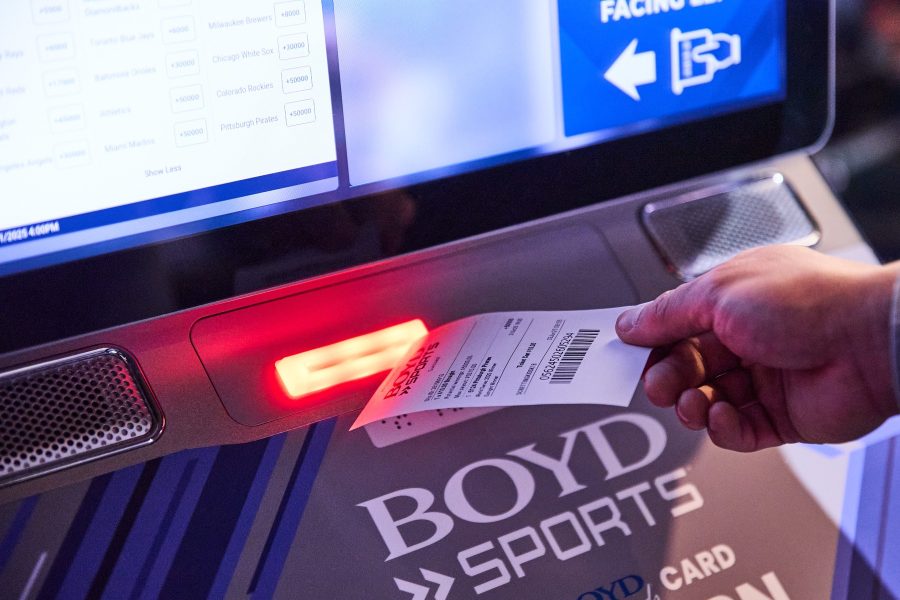At a glance
Expert's Rating
Pros
- Design looks and feels premium
- Great performance
- Beautiful OLED screen
- Speakers are excellent
Cons
- Keyboard and touchpad abandon tactile feedback
- Limited ports (no USB Type-A or HDMI)
- Middle-of-the-road battery life
- Expensive
Our Verdict
The Dell 16 Premium is a premium take on a bad idea. The hardware is powerful, the design is beautiful, and it feels excellent. But the keyboard and trackpad are not pleasant to use.
Price When Reviewed
This value will show the geolocated pricing text for product undefined
Best Pricing Today
Best Prices Today: Dell 16 Premium
The Dell 16 Premium is both impressive and deeply frustrating. Dell has created a high-quality 16-inch laptop that looks and feels great. It has powerful internals — an Intel Arrow Lake CPU and Nvidia GPU — and an excellent OLED screen. This is a laptop built by people who really cared.
But the core design here was a mistake and good craftsmanship can’t save it. For $3,199, you’re getting a keyboard and trackpad experience that looks flashy in photos but feels obnoxious to use. You’re getting high-end internals without common ports (like USB Type-A and HDMI) that people would want in high-end work-focused laptops. And, if minimalism is your priority, the 16-inch size, 4.65-pound weight, and limited battery life here means this machine isn’t ideal for portability.
This is one of the strangest laptops I’ve ever reviewed. Dell tried so hard to make something special and different that it made the day-to-day laptop experience worse. The Dell 16 Premium is a beautiful and expensive hybrid that doesn’t serve any audience particularly well. But it’s so incredibly polished. This is the highest-quality misfire I’ve ever reviewed.
This is the highest-quality misfire I’ve ever reviewed.
Dell 16 Premium: Specs
The Dell 16 Premium is available in a few different configurations starting at $1,999. These configurations all have Intel Arrow Lake CPUs with discrete Nvidia graphics.
We reviewed the $3,199 model, which came with an Intel Core Ultra 7 255H CPU, Nvidia GeForce RTX 5070 graphics, and 32GB of RAM. This high-end model packs a beautiful 4K OLED display with a variable refresh rate up to 120Hz and a touch screen.
Because this is an Intel Arrow Lake CPU, it doesn’t have an NPU fast enough to run Microsoft’s Copilot+ PC features. Dell says this machine has an “AI-enabled Intel processor” on its web page, but the “premium” experience here doesn’t get you access to Windows 11’s latest AI features. Intel’s “Series 2” CPU naming remains baffling to me.
- Model: Dell 16 Premium (DA16250)
- CPU: Intel Core Ultra 7 255H
- Memory: 32GB LPDDR5X 8400MT/s RAM
- Graphics/GPU: Nvidia GeForce RTX 5070, Intel Arc 140T
- NPU: Intel AI Boost
- Display: 16.3-inch 3840×2400 OLED touchscreen with variable refresh rate up to 120Hz
- Storage: 1TB PCIe NVMe SSD
- Webcam: 1080p webcam
- Connectivity: 3x Thunderbolt 4 (USB Type-C), 1x combo audio jack, 1x microSDXC card reader
- Networking: Wi-Fi 7, Bluetooth 5.4
- Biometrics: IR camera and fingerprint reader for Windows Hello
- Battery capacity: 99.5 Watt-hours
- Dimensions: 14.10 x 9.40 x 0.75 inches
- Weight: 4.65 pounds
- MSRP: $3,199 as tested
Dell 16 Premium: Design and build quality
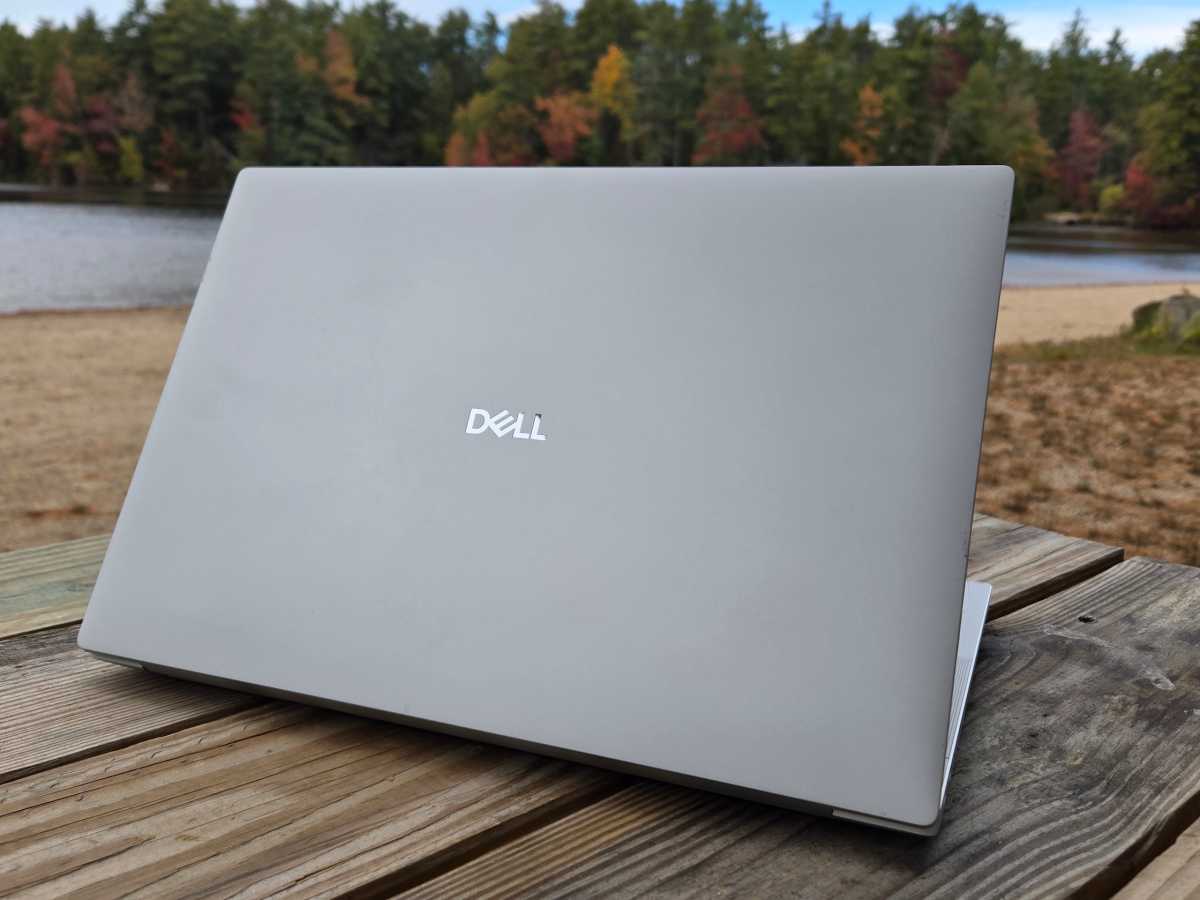
Foundry / Chris Hoffman
The Dell 16 Premium looks beautiful. Our review model’s “Platinum” color scheme is the spitting image of a high-quality silver laptop. It’s a little large and heavy (this is a 4.65-pound 16-inch laptop) so this isn’t a thin-and-light style machine. The chassis is made of aluminum, and the metal and weight gives it a nice heft. The hinge action feels great, too.
When you open it and turn it on for the first time, there’s a bit of a “wow” moment — at least there was for me. I review a lot of laptops, and this machine looks distinct. It’s a clean, minimalist design: a membrane keyboard framed by speakers on each side, and that’s it. (Aside from the obligatory sticker Intel forces PC manufacturers to stick onto their laptops.)
When you turn it on, the function keys light up and it looks premium. The palm rest is one piece of gorilla glass, and it feels smooth to touch and to drag your finger over the trackpad. On this OLED model, the display looks especially vivid and beautiful.
This is a laptop designed to look distinctly good in photos and to feel premium when you touch it in a store. And it delivers.
Dell 16 Premium: Keyboard and trackpad
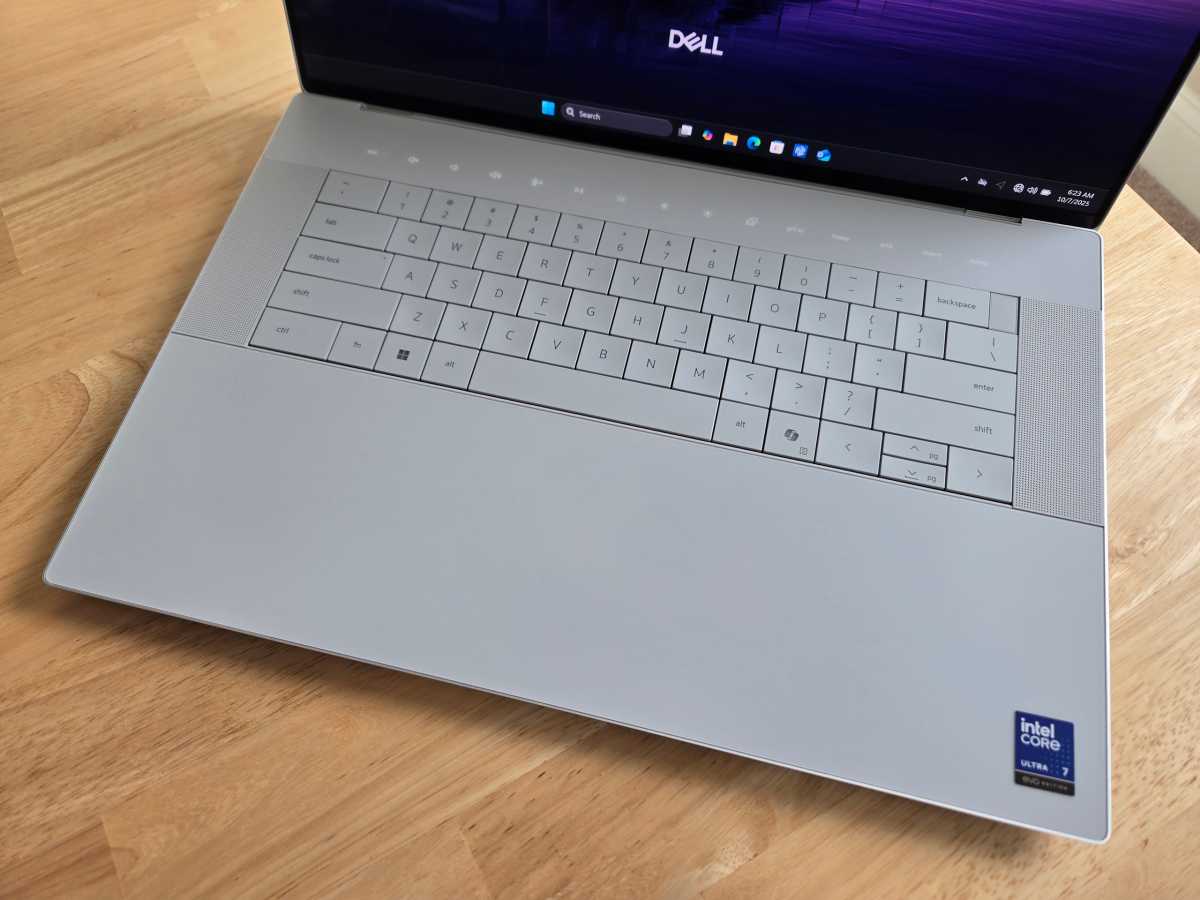
Foundry / Chris Hoffman
Once you start using the laptop, things go downhill fast. The keyboard and trackpad are the worst things here.
The keyboard is large, has nice backlighting, and has a unique look. It’s also not mushy. That’s about all I can say in its favor.
This keyboard only has 1.0mm of key travel, and I feel that low travel with every keypress I make. That’s the kind of extremely low key travel you see on thin-and-light laptops optimized for maximum thinness. It’s not the kind of key travel you see a 4.65-pound machine with a discrete GPU. This means the typing experience just doesn’t feel great.
More obviously, the capacitive function row buttons completely lack tactile feedback. They light up and show different functions when you hold down the Fn key on the keyboard, which is a cool-looking trick. But, without any tactile feedback, you have to look down at the key you’re pressing, tap it, and wait to see if the computer noticed your tap. It feels bad. If PC manufacturers want to do this, they should try to integrate some kind of haptic feedback, a confirmation you pressed the button. That would make this feel a bit better.
The trackpad is also a surreal experience. There is a trackpad at the center of the palm rest in the usual position you’d find one. However, its edges are completely invisible. Without a visual or tactile outline, you must guess where the edge is. This makes mousing around with your finger annoying, and it also causes problems when using multi-finger gestures. On the plus side, it is a haptic trackpad, so that’s nice.
The Dell 16 Premium loses the plot here. It would be better if Dell had used a standard keyboard and trackpad setup. They’ve invested a lot of resources in providing an experience that feels worse to use. And, with the lack of tactile feedback, I don’t think it’s something I would adapt and get used to — even if I bought this machine and used it as my daily driver.
Dell 16 Premium: Display and speakers
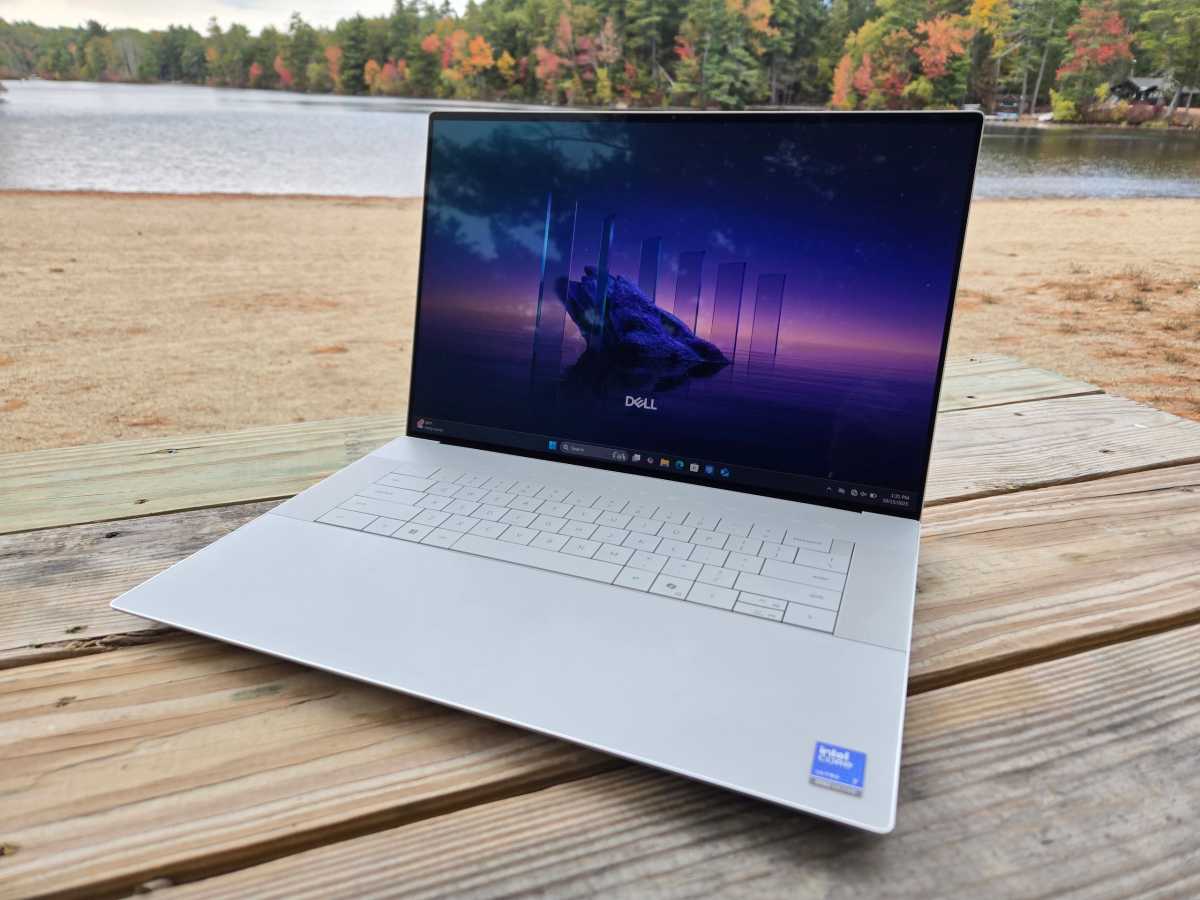
Foundry / Chris Hoffman
The Dell 16 Premium model Dell loaned us for this review had a 16.3-inch 4K OLED display with a variable refresh rate up to 120Hz. It looked vivid and beautiful — like the rest of this machine, it’s a looker.
The main problem with the display is its fairly low brightness for an OLED. It maxes out at 400 nits, and while that’s reasonable enough, many laptops with OLEDs tend to deliver more brightness. I felt like I wanted to keep the brightness cranked up to maximum most of the time, even when using the laptop in a fairly dark room. Combined with the glossy display (a mainstay for OLED panels), this machine isn’t ideal for use outdoors in challenging lighting conditions. However, it did do pretty well on a cloudy New England day in the fall, as you can see in some of my photos.
The Dell 16 Premium boasts a quad speaker setup, and it sounds great for a laptop. There’s plenty of volume. To test laptop speakers, I always fire up Spotify and play Steely Dan’s Aja and Daft Punk’s Get Lucky. The speakers did a surprisingly good job with the crisp instrument separation in Aja, and there was enough bass to deliver a fun sound in Get Lucky. These are unusually good laptop speakers.
Dell 16 Premium: Webcam, microphone, biometrics
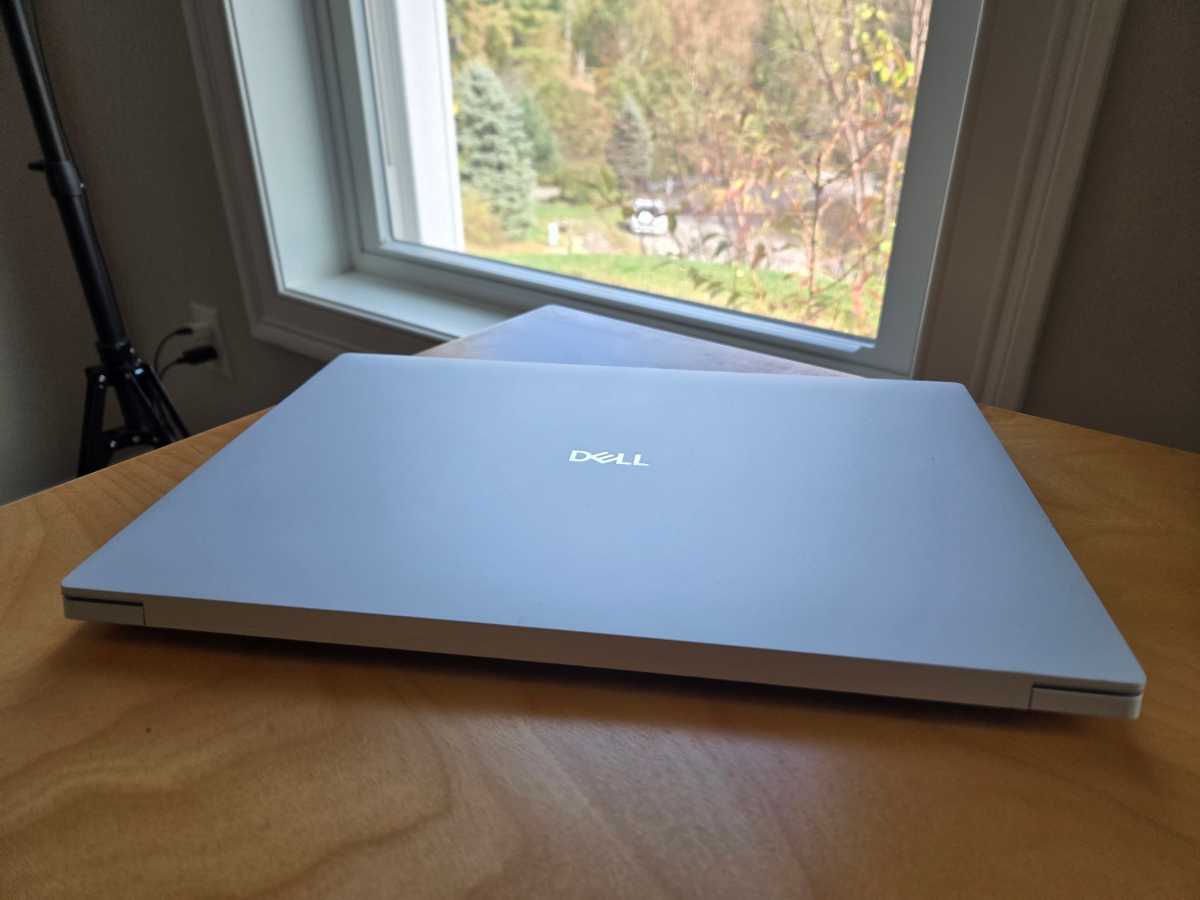
Foundry / Chris Hoffman
The Dell 16 Premium’s 1080p webcam captures a clear, sharp picture, and it looked better than average, even in challenging and dim lighting conditions. I was impressed with the quality of the image.
In keeping with the spirit of minimalism, the Dell 16 Premium doesn’t offer a physical shutter or switch to block the webcam. That’s a shame.
The microphone picks up clear audio with good noise cancellation, and I’d be happy to use it in video meetings, although I’ll stick with a studio mic for my podcast appearances.
The Dell 16 Premium has both facial recognition hardware and a fingerprint reader. You can sign in with your face or touch your finger to the fingerprint reader built into the power button at the top-right corner of the laptop’s keyboard. Both worked well, giving you multiple ways to sign into your PC with Windows Hello.
Dell 16 Premium: Connectivity
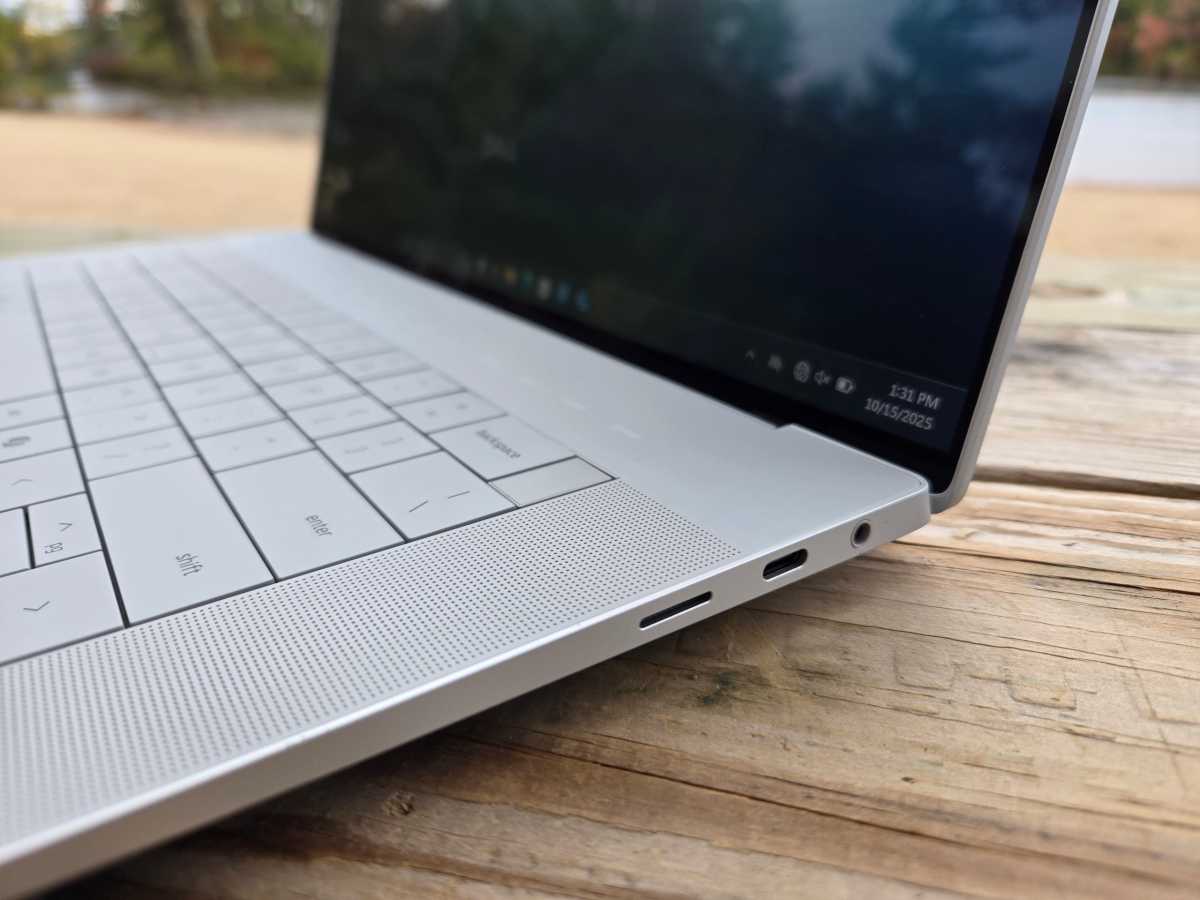
Foundry / Chris Hoffman
The Dell 16 Premium cuts way back on ports compared to the average 16-inch $3,199 laptop with a discrete GPU. It provides three Thunderbolt 4 (USB Type-C) ports — two on the left, and one on the right. It charges via one of these ports, too.
Then, you get a combo audio jack and a microSDXC card reader slot on the right. That’s it. Dell has optimized this machine for a svelte, tapered look, as if a premium laptop means one with fewer ports.
That may fly when we’re talking about thin-and-light minimalist laptops, but I don’t think this makes sense for a 16-inch laptop that’s over 4.5 pounds with discrete graphics. The audience for this type of laptop will want extra ports — USB Type-A, HDMI, and maybe even Ethernet. You’ll probably want to pair this machine with a dongle or dock.
The Dell 16 Premium does have both Wi-Fi 7 and Bluetooth 5.4. It’s nice to see support for the latest wireless standards.
Dell 16 Premium: Performance
The Dell 16 Premium model we reviewed had an Intel Core Ultra 7 255H CPU (Arrow Lake), Nvidia RTX 5070 graphics, 32GB of LPDDR5X RAM running at 8400 MT/s, and a 1 TB PCIe SSD. With specifications like that, it’s no surprise it ran well. These specs are closer to a gaming laptop than the average productivity machine.
The fans stay quiet and there isn’t much heat on the keyboard, even when running demanding tasks. Dell says this laptop has a vapor chamber cooling system, and that’s the kind of high-end touch that does make the hardware feel premium.
We ran the Dell 16 Premium through our standard benchmarks to see how it performs.
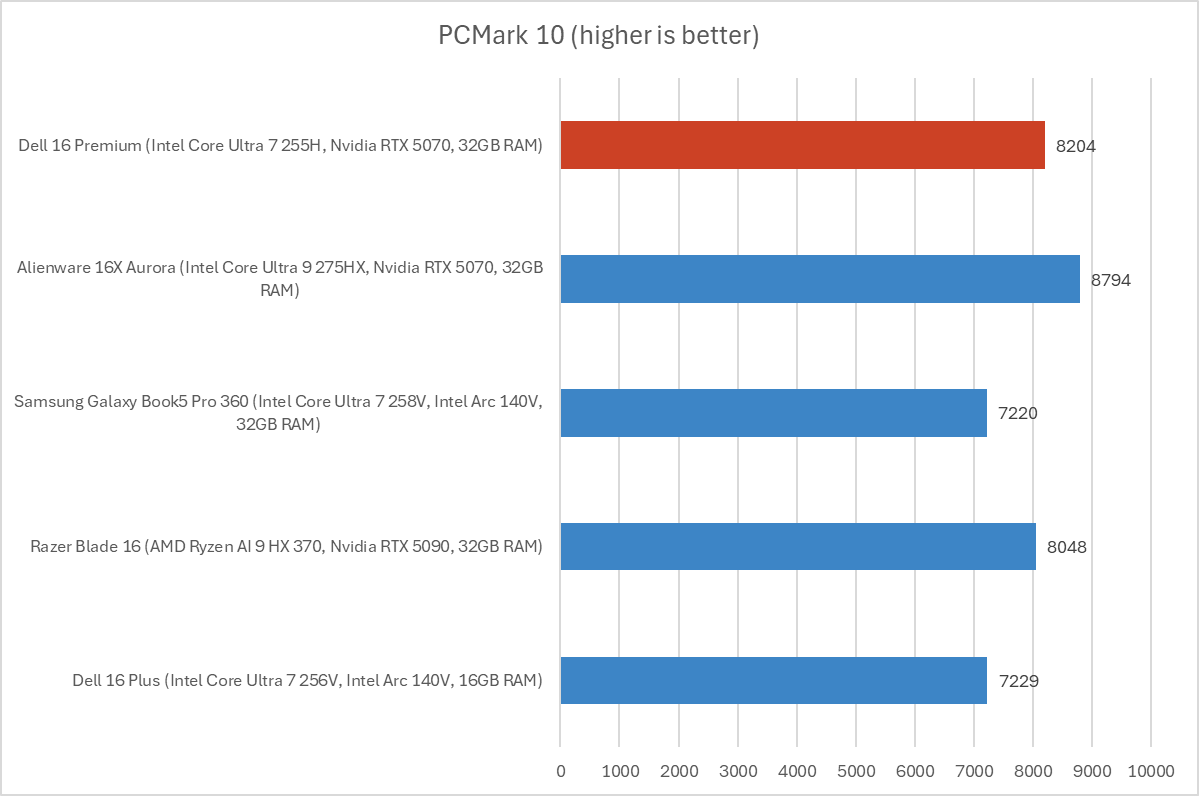
Foundry / Chris Hoffman
First, we run PCMark 10 to get an idea of overall system performance. With an overall PCMark score of 8,204, the Dell 16 Premium delivered excellent performance. It’s closer to what you’d expect to see from a gaming laptop, and that’s no surprise given the high-end hardware and cooling system in this machine.
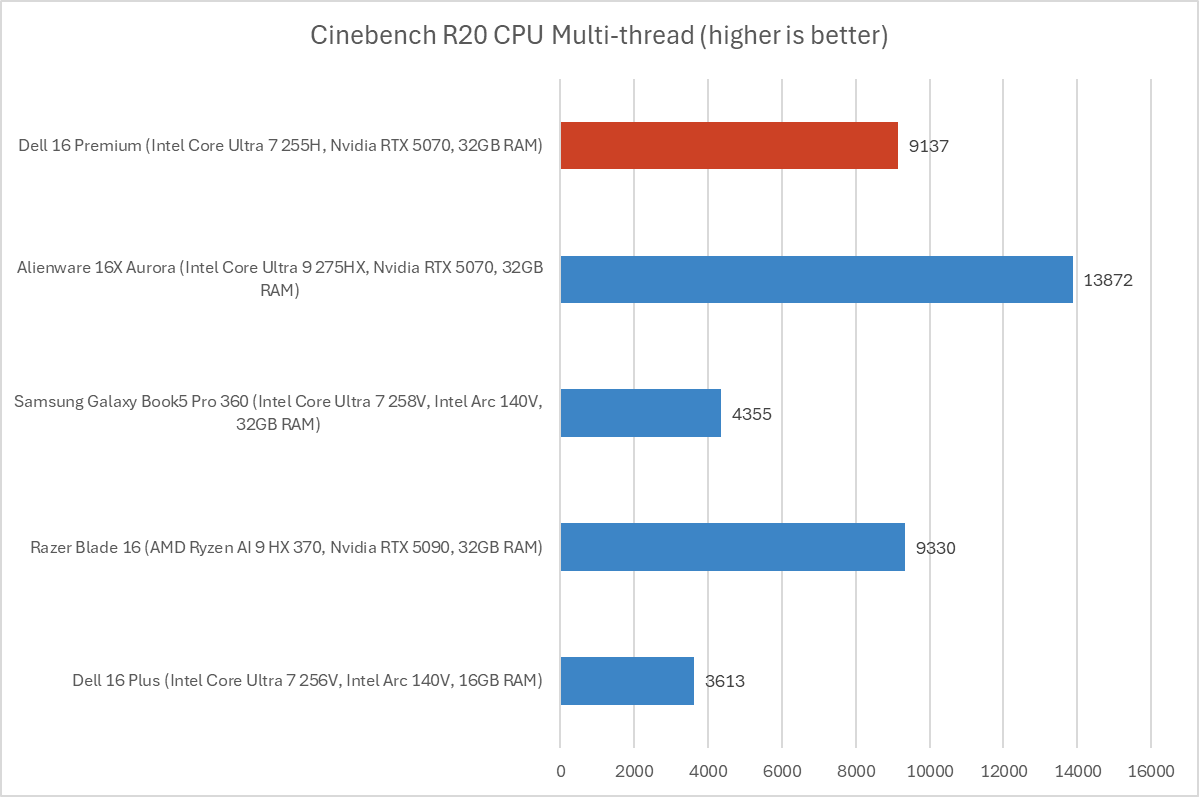
Foundry / Chris Hoffman
Next, we run Cinebench R20. This is a heavily multithreaded benchmark that focuses on overall CPU performance. It’s a quick benchmark, so cooling under extended workloads isn’t a factor. But, since it’s heavily multithreaded, CPUs with more cores have a huge advantage.
With an overall Cinebench R20 score of 9,137, the 16-core Intel Core Ultra 7 255H CPU in the Dell 16 Premium delivered great performance — far exceeding the eight core Intel Lunar Lake CPUs in some other 16-inch laptops. Those slower CPUs are the only Intel CPUs that offer an NPU fast enough for Copilot+ PC AI features. With Intel, you have to compromise one way or another. This machine was neck-and-neck with an AMD-powered system that does deliver an NPU that hits Microsoft’s minimum standards, however.
Laptop buyers should seriously consider whether they want to buy $3,199 machines that aren’t compatible with the latest features in Windows. An AMD chip could have delivered the best of both worlds.
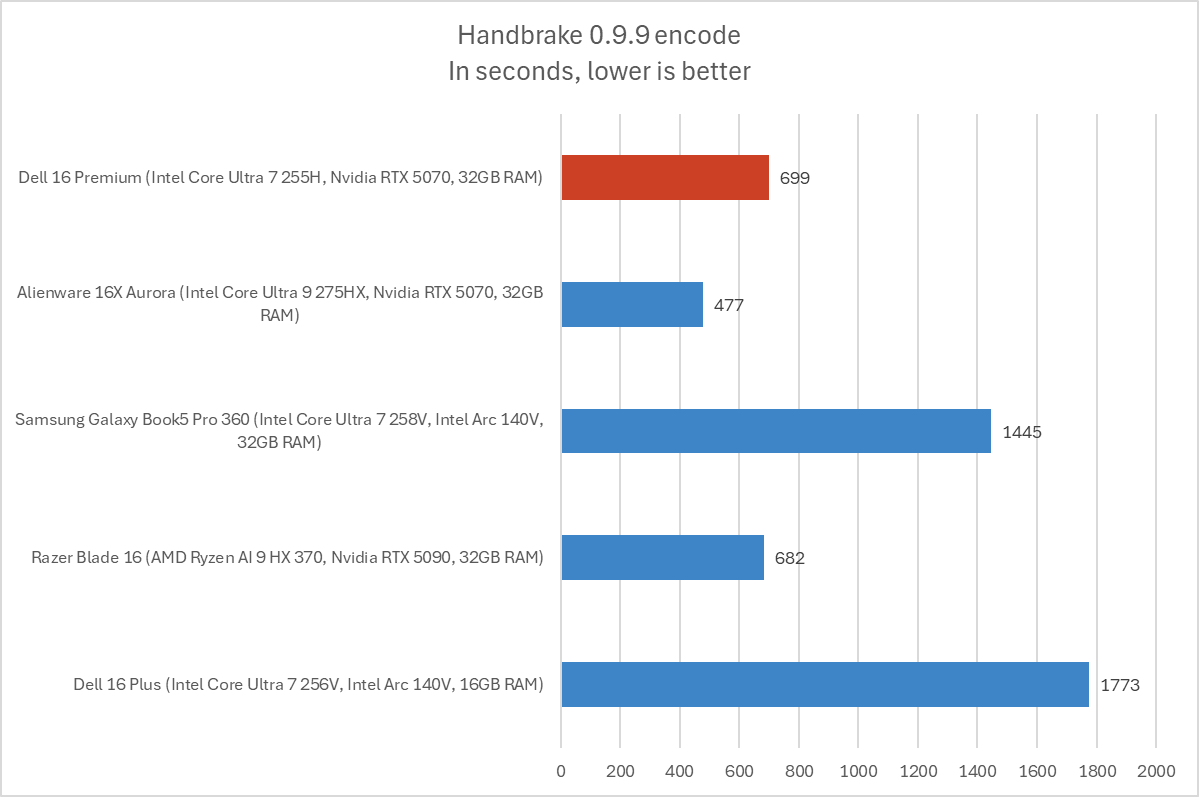
Foundry / Chris Hoffman
We also run an encode with Handbrake. This is another heavily multithreaded benchmark, but it runs over an extended period. This demands the laptop’s cooling kick in, and many laptops will throttle and slow down under load.
The Dell 16 Premium completed the encode process in 699 seconds — that’s just over eleven and a half minutes. It’s a great result that shows this machine’s cooling works well. You’d have to go up to an Intel Core Ultra 9 CPU with more cores for noticeably better performance.
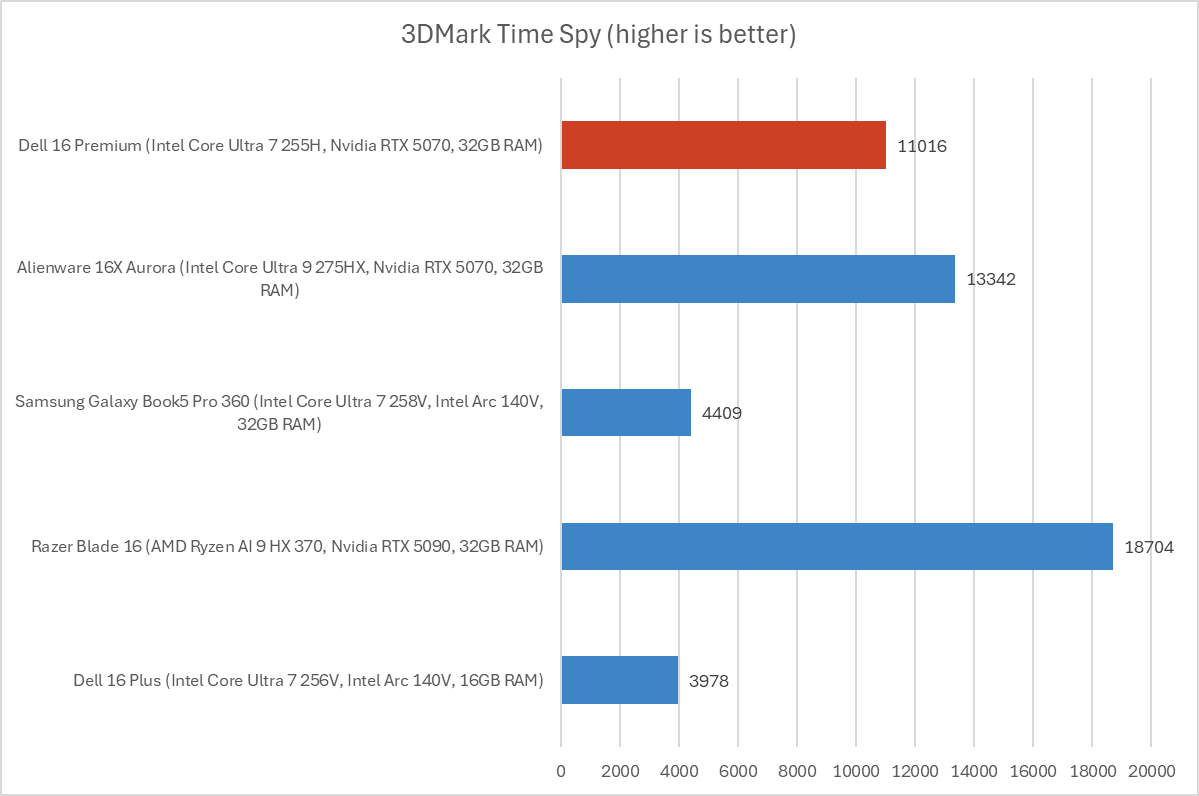
Foundry / Chris Hoffman
Next, we run a graphical benchmark. This isn’t a gaming laptop, but it does have a dedicated Nvidia GeForce RTX 5070 GPU. We run 3DMark Time Spy, a graphical benchmark that focuses on GPU performance.
With a 3DMark Time Spy score of 11,016, the Dell 16 Premium was a little behind the Alienware 16X Aurora, which coincidentally has the same model of GPU. But the GPU’s name isn’t the only thing that matters.
The Alienware 16X Aurora is a gaming laptop that runs the GPU with more power. The Dell 16 Premium runs its RTX 5070 GPU at 65W TGP, while the Alienware 16X Aurora runs its GPU at 115W TGP. So, despite the Nvidia graphics in this PC, you aren’t necessarily getting graphics horsepower on par with a gaming laptop.
Overall, the Dell 16 Premium delivered excellent performance. Unless you plan on upgrading to a Core Ultra 9 CPU or switching to a beefier gaming laptop, you’re not going to do noticeably better.
Dell 16 Premium: Battery life
The Dell 16 Premium has a huge 99.5 Watt-hour battery. That goes right up to the line — the U.S. Transportation Security Administration won’t allow a battery onto an airplane if it’s over 100 Watt hours in size.
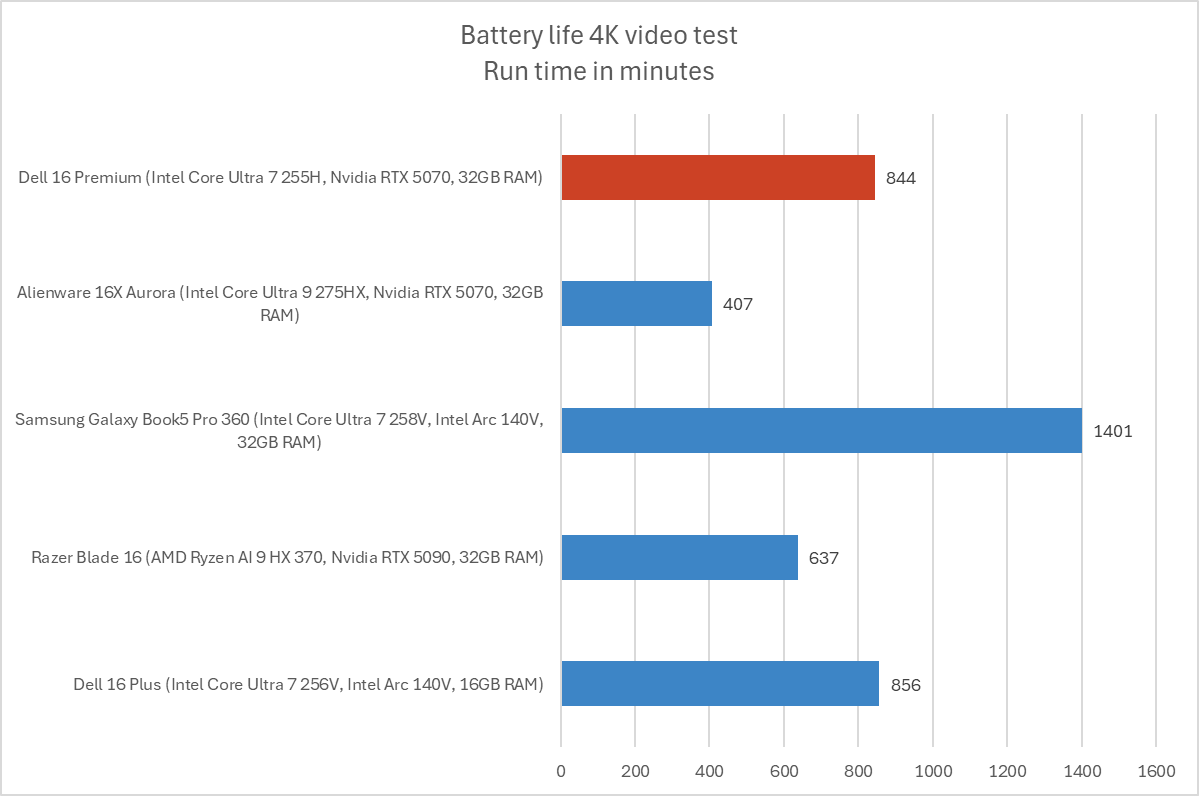
Foundry / Chris Hoffman
To benchmark the battery life, we play a 4K copy of Tears of Steel on repeat on Windows 11 with airplane mode enabled until the laptop suspends itself. We set the screen to 250 nits of brightness for our battery benchmarks. This is a best-case scenario for any laptop since local video playback is so efficient, and real battery life in day-to-day use is always going to be less than this.
The Dell 16 Premium lasted 844 minutes on average, which is about 14 hours. That’s reasonable. But, in the real world, that doesn’t necessarily mean you’ll make it through an eight hour workday, especially not if you’re running the demanding software this machine feels like it was built for.
The Samsung Galaxy Book5 Pro 360, with its slower Intel Lunar Lake processor, lasted over 23 hours in our benchmarks. If you’re eyeing this machine for its sleekness and minimalism, a machine like that Galaxy Book may be more up your alley.
Dell 16 Premium: Conclusion
The Dell 16 Premium is an excellent, well-built machine with serious care and craftsmanship put into it. It’s also a confused hybrid that feels designed by committee. By trying to marry high-end hardware with a svelte laptop experience, Dell has created a compromised experience.
But the biggest problem is the keyboard and trackpad. The lack of tactile feedback and the very low 1.0mm of key travel means this laptop isn’t great to type on for long periods of time. At $3,199, that just feels unacceptable.
For what it’s worth, a Dell representative noted this particular configuration has already been on sale for as much as $400 off the retail price. The PC market is all about sales, and prices are hard to pin down.
Still, I feel a little bad knocking this laptop. The Dell 16 Premium is built on a vision that doesn’t really make sense. But, after the idea stage, everyone involved knocked it out of the park and did an incredible job of bringing that vision to life.



